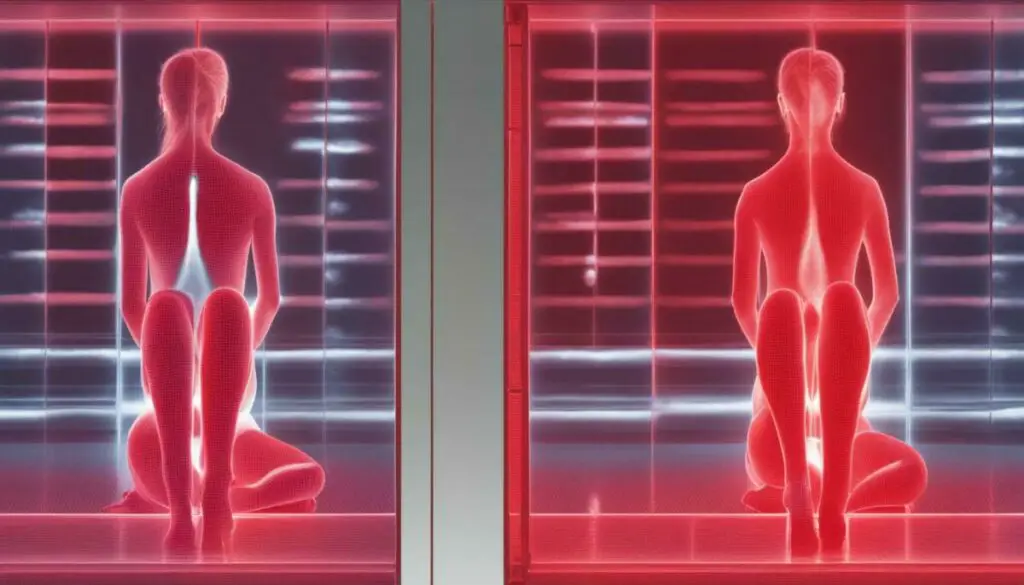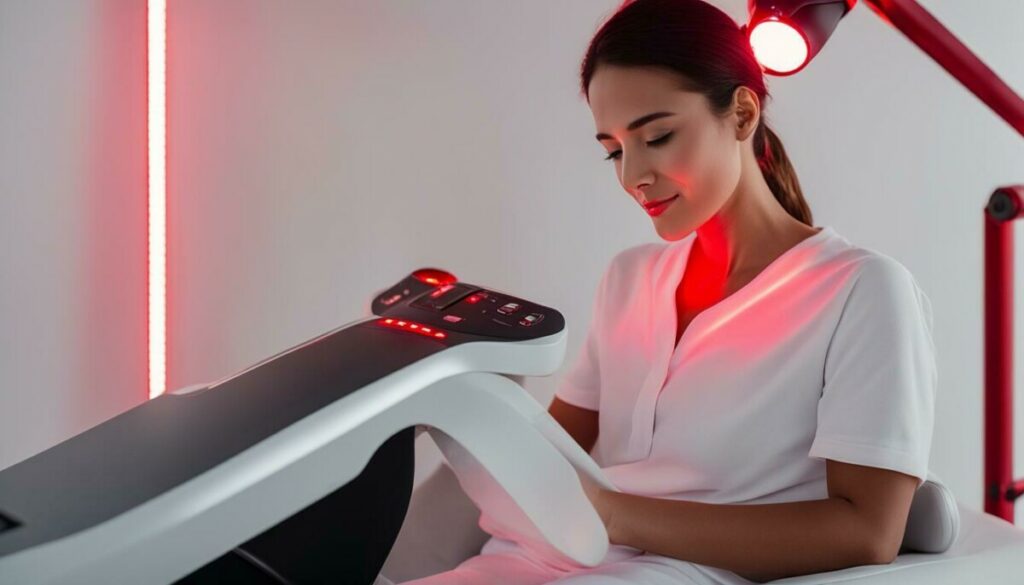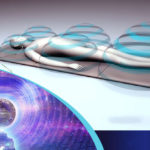Last Updated on 7 months by Francis
When it comes to wellness therapies, many people are turning to light-based treatments like near infrared therapy and red light therapy. These therapies use different wavelengths of light to target various conditions, from pain relief to skin health and cell regeneration. But what are the differences between these therapies, and which one is right for you? In this article, we will explore the key benefits and differences of near infrared therapy and red light therapy.
Contents
Key Takeaways:
- Near infrared therapy and red light therapy use different wavelengths of light to target various wellness conditions.
- Near infrared therapy uses longer wavelengths that can penetrate deeper into tissues, while red light therapy uses visible light wavelengths that primarily affect the surface of the skin.
- Near infrared therapy offers benefits for pain relief and cell regeneration, while red light therapy is known for its skin health benefits and collagen production.
- The choice between near infrared therapy and red light therapy ultimately depends on your specific needs and preferences.
- Consult with a healthcare professional or wellness practitioner to determine which therapy is best suited for you on your wellness journey.
What is Near Infrared Therapy?
Near infrared therapy is a type of light therapy that uses wavelengths that are longer than visible light, ranging from 700 to 1200 nanometers. This therapy is known for its ability to penetrate deeply into the body, which can provide a range of health benefits.
One of the key benefits of near infrared therapy is its ability to improve circulation and reduce inflammation, making it a popular choice for pain relief. It can also help stimulate cell regeneration and collagen production, leading to enhanced skin health and anti-aging benefits.

Another benefit of near infrared therapy is its potential to aid in muscle recovery. The deep penetrating wavelengths of near infrared light can improve blood flow and oxygenation to the muscles, helping to reduce exercise-induced muscle fatigue and promote faster recovery.
Overall, near infrared therapy is a safe and non-invasive therapy that offers a wide range of benefits for those seeking to improve their overall wellness. Whether you are looking for pain relief, skin health, or muscle recovery, near infrared therapy may be an effective option for you.
What is Red Light Therapy?
Red light therapy is a non-invasive treatment that uses low-level light wavelengths to promote healing and rejuvenation. Red light therapy uses visible light wavelengths ranging from 620 to 700 nanometers, which can penetrate the top layers of the skin and be absorbed by the cells in the body.
Benefits of red light therapy include improved skin health, reduced wrinkles and fine lines, and improved muscle recovery. This therapy has also been found to reduce joint pain and inflammation, making it beneficial for those with arthritis or other inflammatory conditions.
Research has shown that red light therapy can promote collagen production, which is essential for maintaining healthy and youthful-looking skin.

Red light therapy works by stimulating the mitochondria in cells, leading to increased energy production and improved cellular function. This results in improved skin health, muscle recovery, and reduced pain and inflammation in the body.
“Red light therapy has been found to be beneficial for a variety of conditions, including skin conditions, joint pain, and muscle recovery.”
Overall, red light therapy is a safe and effective treatment option for those looking to improve their skin health and reduce pain and inflammation. Consult with a healthcare professional or wellness practitioner to determine if red light therapy is right for you.
Key Differences Between Near Infrared and Red Light Therapy
While both near infrared and red light therapy offer therapeutic benefits, they differ in terms of the wavelengths used. Near infrared therapy utilizes longer wavelengths that can penetrate deeper into tissues, whereas red light therapy uses visible light wavelengths that primarily affect the surface of the skin.
The targeted benefits and treatment areas may vary between the two therapies. Near infrared therapy is commonly used for pain relief, muscle recovery, and cell regeneration, while red light therapy is popular for its skin health benefits, such as promoting collagen production and reducing the appearance of wrinkles.
It is important to note that while the wavelengths used in each therapy may differ, both near infrared and red light therapy have been shown to improve physical health and wellbeing. The choice between these therapies ultimately depends on your specific needs and preferences, so consider consulting with a healthcare professional or wellness practitioner to determine which therapy is best suited for you.

Near Infrared Therapy for Pain Relief
If you suffer from chronic pain, near infrared therapy may provide the relief you need. This therapy has been shown to have promising results for pain relief and reduction of inflammation.
Conditions such as arthritis, muscle soreness, and joint pain may benefit from near infrared therapy. The deep-penetrating wavelengths of near infrared light can improve blood flow and circulation, leading to reduced discomfort and increased mobility.
In fact, a 2016 study found that near infrared therapy was effective in reducing pain and improving function in patients with knee osteoarthritis. The study concluded that near infrared therapy could be a useful non-invasive treatment for managing pain in individuals with this condition.

In addition to its pain-relieving benefits, near infrared therapy may also aid in the recovery of muscle injuries. By increasing circulation and oxygenation to the muscles, this therapy can support their repair and recovery, reducing the time it takes to bounce back from an injury or strenuous workout.
Consult with a healthcare professional or wellness practitioner to see if near infrared therapy is the right choice for you and your pain management needs.
Red Light Therapy for Skin Health
Red light therapy is a non-invasive treatment that can improve skin health in various ways. The therapy uses wavelengths of light ranging from 620 to 700 nanometers to stimulate collagen production, promote wound healing, and reduce inflammation.
Collagen is a protein that gives skin its elasticity and youthful appearance. As we age, collagen production decreases, resulting in wrinkles and fine lines. Red light therapy can help reverse this process by boosting collagen synthesis, leading to smoother, more radiant skin.
In addition to improving collagen production, red light therapy can also reduce the appearance of scars, blemishes, and other skin imperfections. By promoting wound healing and reducing inflammation, this therapy can help speed up the recovery process and minimize the risk of infections.

One of the major benefits of red light therapy for skin health is that it is a non-invasive, painless treatment that can be done in the comfort of your own home or at a wellness center. The therapy is safe for all skin types and does not require any downtime, making it a popular choice among those looking to improve their skin health without undergoing more invasive procedures.
Overall, red light therapy is a safe and effective way to improve skin health, reduce the appearance of wrinkles and fine lines, and promote overall skin rejuvenation.
Near Infrared Therapy for Cell Regeneration
If you’re looking for a therapy that can help enhance cellular function and promote tissue repair, near infrared therapy may be worth considering. By using light waves that penetrate deeper into the body, near infrared therapy can stimulate the mitochondria in cells, leading to increased energy production and improved cellular function.
Studies have shown that near infrared therapy can have potential applications in wound healing, tissue repair, and overall cellular rejuvenation. This therapy can also help improve circulation and reduce inflammation, which can further aid in the healing process.
One of the unique benefits of near infrared therapy is its ability to penetrate deep into tissues. This deep penetration can help target areas that are difficult to reach with other therapies, making it a promising option for conditions that require deep tissue healing.
So if you’re looking for a therapy that can help promote cell regeneration and overall cellular health, near infrared therapy may be a great option to consider.

Red Light Therapy for Collagen Production
Red light therapy has been extensively studied for its ability to enhance collagen production, an essential protein that provides structure and elasticity to the skin. Collagen production decreases with age, resulting in the formation of wrinkles and fine lines.
Red light therapy, which utilizes wavelengths of light between 620 to 700 nanometers, stimulates the fibroblasts in the skin to produce more collagen. The light energy is absorbed by the cells, triggering a cascade of events that lead to increased collagen synthesis.

Studies have shown that red light therapy can improve skin texture and reduce the appearance of wrinkles and fine lines. It can also aid in wound healing and reduce inflammation associated with acne breakouts.
Red light therapy has also been found to have benefits beyond skin health. It may improve joint health by promoting collagen production in cartilage, leading to improved joint mobility and reduced pain.
Incorporating red light therapy into your wellness routine may help enhance collagen production in your skin and improve overall joint health.
Near Infrared Therapy for Muscle Recovery
For athletes and fitness enthusiasts, muscle recovery is an essential part of their wellness routine. Near infrared therapy may offer benefits for muscle recovery by increasing blood flow and oxygenation to the muscles.
A study published in the Journal of Athletic Training found that near infrared therapy reduced muscle fatigue and improved muscle recovery in a group of male college athletes. The therapy was applied for 20 minutes immediately after exercise, leading to a significant reduction in muscle fatigue and improved muscle function compared to a placebo group.
Another study published in the Journal of Strength and Conditioning Research found that near infrared therapy helped improve muscle recovery in a group of female athletes. The therapy was applied for 13 minutes per leg, resulting in reduced muscle soreness and increased muscle performance.
Overall, these studies suggest that near infrared therapy may have benefits for muscle recovery and reducing exercise-induced fatigue. Consult with a healthcare professional or wellness practitioner to determine whether near infrared therapy may be suitable for your muscle recovery needs.

Conclusion
After comparing near infrared therapy and red light therapy, it is clear that both offer unique benefits for pain relief, skin health, cell regeneration, collagen production, and muscle recovery.
The targeted benefits of the two therapies may vary, with near infrared therapy offering deeper tissue penetration and red light therapy primarily affecting the surface of the skin. Consult with a healthcare professional or wellness practitioner to determine which therapy is best suited for you on your wellness journey.
Further Research
If you are interested in learning more about near infrared vs red light therapy, we encourage you to explore the available research and consult with a knowledgeable expert. Both therapies have been studied extensively and continue to show promise in a variety of applications. By understanding the unique benefits of each therapy, you can make informed choices for your health and wellness goals.
FAQ
What is the difference between near infrared therapy and red light therapy?
Near infrared therapy uses longer wavelengths of light to penetrate deeper into the body, while red light therapy uses visible light wavelengths that primarily affect the surface of the skin.
What are the benefits of near infrared therapy?
Near infrared therapy can improve circulation, reduce inflammation, relieve pain, promote cell regeneration, and stimulate collagen production, leading to enhanced skin health and anti-aging benefits.
What are the benefits of red light therapy?
Red light therapy improves skin health by promoting collagen production, reducing the appearance of wrinkles and fine lines. It also aids in muscle recovery and reduces joint pain.
How does near infrared therapy work for pain relief?
Near infrared therapy reduces inflammation, improves blood flow, and promotes cell regeneration, which can help alleviate pain in conditions like arthritis, muscle soreness, and joint pain.
How does red light therapy benefit skin health?
Red light therapy stimulates collagen production, improving skin elasticity, reducing wrinkles, and evening out skin tone. It also promotes wound healing and reduces inflammation related to acne.
How does near infrared therapy promote cell regeneration?
Near infrared therapy stimulates mitochondria in cells, enhancing energy production and improving cellular function. It may have applications in wound healing, tissue repair, and overall cellular rejuvenation.
How does red light therapy stimulate collagen production?
Red light therapy enhances collagen synthesis, reducing the appearance of wrinkles and improving skin texture. It may also benefit joint health and promote hair growth.
How does near infrared therapy aid in muscle recovery?
Near infrared therapy improves blood flow and oxygenation to muscles, aiding in their repair and recovery after exercise-induced fatigue.
Which therapy should I choose, near infrared or red light?
The choice between near infrared therapy and red light therapy depends on your specific needs and preferences. Consult with a healthcare professional or wellness practitioner to determine which therapy is best suited for you on your wellness journey.









